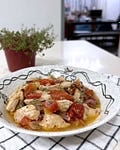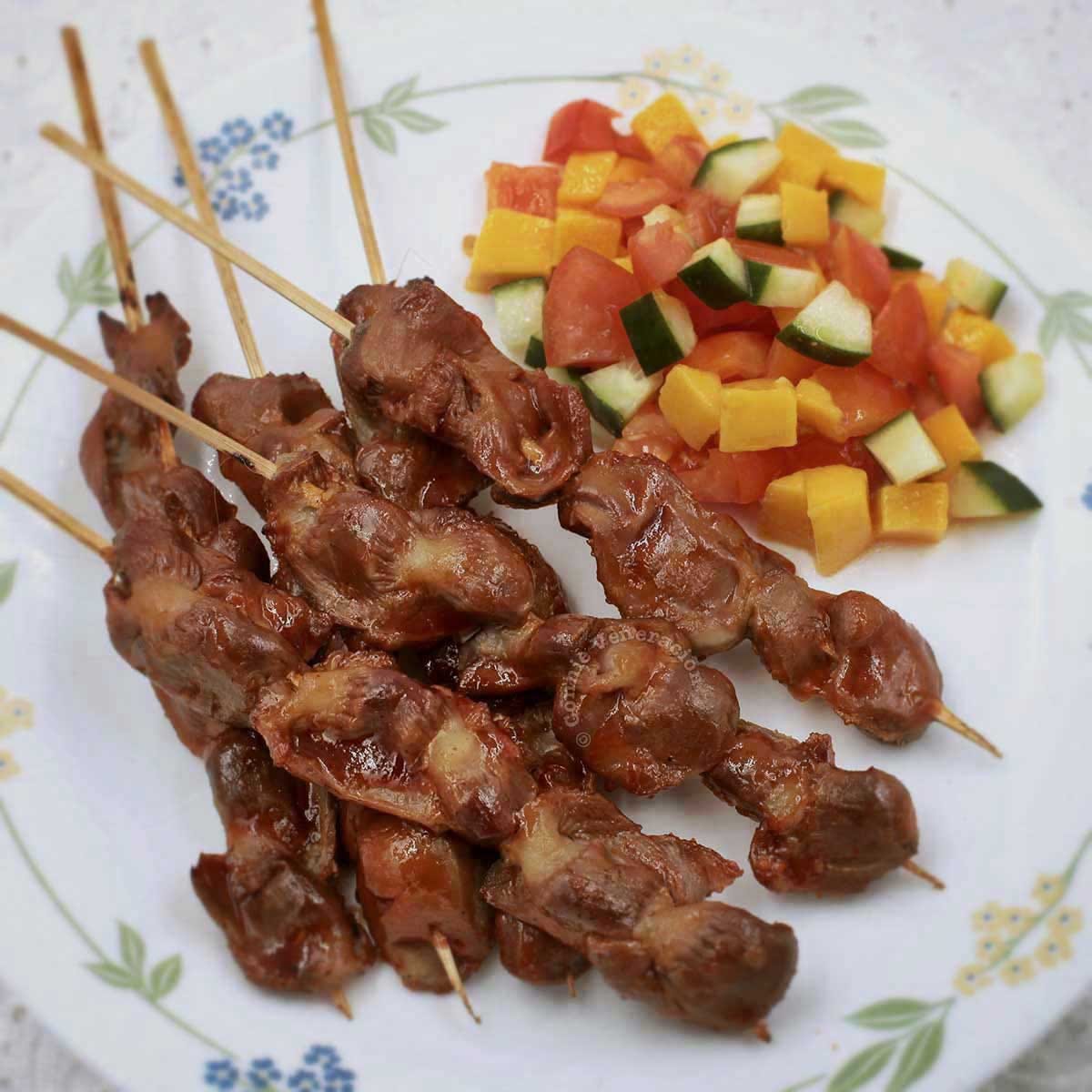#22 The art of cooking cheap, part three
We buy and consume chicken differently here at home. But we do use most parts in the best way we can.
How’s your Saturday going? The hot and dry season is well upon us here in the tropics, I quickly caught a bug and was down for days (I stayed in bed, mostly), it’s the first day in a week that I feel 100% okay, and I’m just hoping you’re doing better. I’m staying indoors, and likely to stay indoors until the monsoon season begins. Because… just look at this.
That’s from Accuweather. Just note that pink box (highlight mine) and imagine what it’s like in the kitchen unless the aircon is turned on. But electricity is expensive in this country. The rate is currently the second highest in Asia — Singapore takes top spot but it is a rich country and the Philippines is not.
So, you know, cooking meals for the entire day is done in one go to minimize the use of the aircon in the kitchen. Even with inverter-type aircons in the house, the electric bill can still be horrifying. Just sharing my reality.
This newsletter is about chicken. Which parts of the bird we eat, some of which you probably discard.
First, some honest facts.
We rarely buy a whole chicken. We buy chicken by cut. A kilogram of bone-in thighs with or without the legs, a kilogram of boneless skin-on thighs, a kilogram of wings and, if my older daughter is home for the weekend (she works and stays in the city), we get chicken breast. She really is the only one in our family who likes white meat. If we buy a whole chicken every time, one person gets 50% of the meat (the breast) and the rest of us have to make do with what’s left. Not fair.
When I need to replenish our stock of chicken broth, I buy a kilogram of necks and backbones, simmer them, strain them and I have a pot of broth. After cooling, I divide them into portions and freeze them.
If we’re craving some other part of the chicken, like liver or gizzard or skin for making cracklings, we buy them by the kilogram as well.
I know, it’s different. Much different from how chicken is sold and consumed in other regions, especially in the First World where breast meat is preferred because it’s the meatiest. Personally, I find that it has the least flavor, and it is the least succulent because it is too lean.
But how does buying chicken by cut (rather than whole) translate to smart kitchen economics?
It’s really about usage. And I’ll cite an example to illustrate.
You watch Ina Garten’s cooking shows? I used to. In one show, she was showing how to make chicken broth using a whole chicken. She simmered it with vegetables for hours. When the simmering ended, she said, the chicken was already tasteless at that point and unusable.
I was so shocked.
When I make chicken broth, unless I already have the carcass of, say, a whole roasted chicken, I prefer to use a kilogram (or more) of chicken necks. By weight, they cost so much cheaper than a whole chicken. While there is very little meat to be picked, we do save the skin, dry them out on a rack, toss them in flour and fry them into cracklings.
I do my math (though I’m not so good at it)
One month’s supply of chicken in our household is usually about four to five kilograms of meat plus what I need to make broth. The cut varies from month to month, sometimes, we buy more fillets than bone-in cuts, sometimes it’s the reverse. At current prices, here’s an example of how it’s broken down per kilogram:
Skin-on thigh fillets - PHP300 (USD5.36)
Skin-on breast fillets - PHP300 (USD5.36)
Chicken wings (drumettes, wingettes and wingtips) - PHP210 (USD3.75)
Chicken bone-in leg quarters - PHP298 (USD5.33)
Chicken gizzards - PHP144 (USD2.57)
Chicken necks - PHP 124 (USD2.21)
Price source: Landers (that’s where I shop most often)
The total is PHP1376 (USD24.62) for six kilograms of different chicken cuts for various dishes.
Now, if I buy instead whole chickens that total six kilograms in weight, the total cost is PHP1440 (USD25.77)
The difference of a little over a dollar may not mean much in the U.S., but in the Philippines, the difference of over a thousand pesos is A LOT — more than enough to buy a kilogram of large shrimps.
(Sorry, bad math. The difference is over fifty pesos and that won’t buy a hundred grams of shrimps).
In terms of usage, the different cuts go a long, long way. The fillets go into stir fries and Asian-style fried chicken like:
The wings are fried or grilled (if there is a generous amount of breast meat attached to the drumettes, I cut those off and use them for another dish).
The leg quarters are fried, roasted, stewed or cooked into chunky soups.
The gizzards are cooked in different ways (more on that below) and the necks are made into broth.
Not only do we get variety in the dishes we cook and serve, we are also able to use the ideal cut for each dish.
Meanwhile, six kilograms of whole chickens translate to so much chicken breast meat, too much bones and not as much red meat. That makes only one person in the family happy.
Recipes that illustrate smart use of chicken cuts
Chicken, tomatoes and thyme in olive oil - A kilogram and a half of chicken wings was cooked into chicken 1-2-3, but the generous amount of breast meat attached to the drumettes (or little drumsticks if that’s how you prefer to call them) were cut off and saved to cook a second dish. This is that second dish. Get the recipe.
Now, about gizzards. You might want to read a post dedicated to tenderizing the tough meat before diving into recipes. Done? Here are a few ideas on how to enjoy chicken gizzards.
Chicken gizzards and banana stir fry - Inspired by the Nigerian dish called gizdodo, boiled chicken gizzards are stir fried with spices then tossed with fried saba bananas. Get the recipe.
Chicken gizzards and Sriracha stir fry - In this recipe, the gizzards are simmered with herbs and spices until tender before they are stir fried with Sriracha sauce, lime juice and honey. Get the recipe.
Inihaw na balon-balonan ng manok (skewered and grilled chicken gizzards) - Barbecued balon-balonan ng manok, or chicken gizzards, is a popular street food in the Philippines. Along with barbecued chicken feet, pork ears and isaw (intestines), it is a favorite finger food that goes well with beer. Get the recipe.
In the next newsletter, since so many are already embarking on “revenge travel”, let me share some of my favorite eats around Asia.







